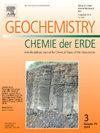塔曼拉塞特W-Sn-(±Ta-Nb-Li)花岗岩的地球化学和年代学特征:阿尔及利亚Laouni地体中稀有金属岩浆作用
IF 2.9
3区 地球科学
Q2 GEOCHEMISTRY & GEOPHYSICS
引用次数: 0
摘要
尽管进行了广泛的地球化学和年代学研究,但霍格格地块中部黄玉云母花岗岩的起源及其相关的稀有金属成矿作用仍然是一个引人注目的主题。本文对老泥地体塔曼拉塞特(Tamanrasset) W-Sn-(±Ta-Nb-Li)花岗岩进行了新的体岩地球化学数据和锆石UPb年龄、Hf同位素组成,并对NdSm同位素进行了补充分析。这些资料增强了对所调查花岗岩的形成和构造背景的认识。岩石学和地球化学分析确定了四种花岗岩品种:细粒二长花岗岩、含萤石的二云母花岗岩、斑状黄玉-碱长石花岗岩和黄玉-云母-钠长石花岗岩。一般来说,这些岩石是低p (P2O5 <;从弱铝质到强过铝质(A/CNK = 0.94-1.83),具有高度的分数结晶(50 - 90%),富含F、Rb、W、Sn、Cs、Y、Zr和Ta。研究岩石具有明显的稀土元素模式,含黄玉和萤石花岗岩具有强烈的负Eu异常(Eu/Eu*≤0.1)和m型四分体效应,二长花岗岩异常较弱。锆石饱和度测温和PH2O测压表明,在低温富水条件下(11-15 MPa, <;800°C),具有高氟活性和富含挥发物的相,表明是浅的演化岩浆。锆石UPb定年确定alemsamuda二长花岗岩的年龄为605.4±3.7 Ma,黄玉-碱长石花岗岩的年龄为603.2±2.6 Ma,黄玉-云母-钠长石花岗岩的年龄为592.9±3.9 Ma, Tin Amzi-El Karoussa两云母花岗岩的年龄更小(~ 575-572 Ma)。相反,hanana - hanan本文章由计算机程序翻译,如有差异,请以英文原文为准。
Geochemical and geochronological characterization of the Tamanrasset W-Sn-(±Ta-Nb-Li) granites: Prolonged rare metal magmatism in the Laouni terrane (Central Hoggar, Algeria)
The origin of topaz-mica granites within the central Hoggar massif, along with their associated rare metal mineralization, remains a compelling subject despite extensive geochemical and geochronological research. This study presents new bulk-rock geochemical data and zircon U![]() Pb ages and Hf isotopic composition for the Tamanrasset W-Sn-(±Ta-Nb-Li) granites in the Laouni terrane, supplemented by Nd
Pb ages and Hf isotopic composition for the Tamanrasset W-Sn-(±Ta-Nb-Li) granites in the Laouni terrane, supplemented by Nd![]() Sm isotope analyses. These data enhance the understanding of the formation and tectonic setting of the investigated granites.
Sm isotope analyses. These data enhance the understanding of the formation and tectonic setting of the investigated granites.
Petrographic and geochemical analyses identify four granite varieties: fine-grained monzogranite, fluorite-bearing two-mica granite, porphyritic topaz-alkali feldspar granite, and topaz-mica-albite granite. Generally, these rocks are low-P (P2O5 < 0.14 wt%) and range from weakly metaluminous to strongly peraluminous (A/CNK = 0.94–1.83), with high degrees of fractional crystallization (50–90 %) evidenced by enrichment in F, Rb, W, Sn, Cs, Y, Zr, and Ta. The studied rocks feature distinct REE patterns, including strong negative Eu anomalies (Eu/Eu* ≤ 0.1) and M-type tetrad effects in topaz- and fluorite-bearing granites, while monzogranite shows weaker anomalies. Zircon saturation thermometry and PH2O barometry suggest crystallization under low-temperature, water-rich conditions (11–15 MPa, < 800 °C), with high fluorine activity and volatile-rich phases, suggesting shallow, evolved magmas. Zircon U![]() Pb dating defined ages of 605.4 ± 3.7 Ma for Aleméda monzogranite, 603.2 ± 2.6 Ma for topaz-alkali feldspar granite, and 592.9 ± 3.9 Ma for topaz-mica-albite granite, with younger ages (∼575–572 Ma) in two-mica granites from Tin Amzi-El Karoussa. Conversely, the Hanana-Hananère topaz-mica-albite granite has a distinctly older age of 638.0 ± 3.1 Ma.
Pb dating defined ages of 605.4 ± 3.7 Ma for Aleméda monzogranite, 603.2 ± 2.6 Ma for topaz-alkali feldspar granite, and 592.9 ± 3.9 Ma for topaz-mica-albite granite, with younger ages (∼575–572 Ma) in two-mica granites from Tin Amzi-El Karoussa. Conversely, the Hanana-Hananère topaz-mica-albite granite has a distinctly older age of 638.0 ± 3.1 Ma.
The studied granites show diverse REE profiles, zircon εHf(t) (−3.6 to −13.3), bulk-rock εNd(t) (0.3 to −16.3), and model ages (1.3–2.4 Ga), indicating crustal reworking, mantle delamination, and partial melting. Orogenic collapse and mantle delamination triggered magmatic activity, leading to volatile-rich, evolved ferroan A2-type granites with rare-metal mineralization potential. Their isotopic variability suggests a transcrustal MASH system driven by mantle-crust interactions, with strong spatial association to mega shear zones, highlighting tectonic control on magma ascent and crustal reworking, and incorporation of ancient crustal materials.
求助全文
通过发布文献求助,成功后即可免费获取论文全文。
去求助
来源期刊

Chemie Der Erde-Geochemistry
地学-地球化学与地球物理
CiteScore
7.10
自引率
0.00%
发文量
40
审稿时长
3.0 months
期刊介绍:
GEOCHEMISTRY was founded as Chemie der Erde 1914 in Jena, and, hence, is one of the oldest journals for geochemistry-related topics.
GEOCHEMISTRY (formerly Chemie der Erde / Geochemistry) publishes original research papers, short communications, reviews of selected topics, and high-class invited review articles addressed at broad geosciences audience. Publications dealing with interdisciplinary questions are particularly welcome. Young scientists are especially encouraged to submit their work. Contributions will be published exclusively in English. The journal, through very personalized consultation and its worldwide distribution, offers entry into the world of international scientific communication, and promotes interdisciplinary discussion on chemical problems in a broad spectrum of geosciences.
The following topics are covered by the expertise of the members of the editorial board (see below):
-cosmochemistry, meteoritics-
igneous, metamorphic, and sedimentary petrology-
volcanology-
low & high temperature geochemistry-
experimental - theoretical - field related studies-
mineralogy - crystallography-
environmental geosciences-
archaeometry
 求助内容:
求助内容: 应助结果提醒方式:
应助结果提醒方式:


